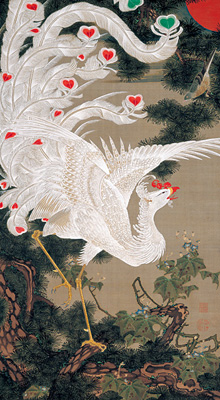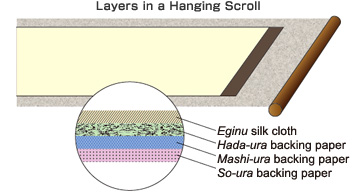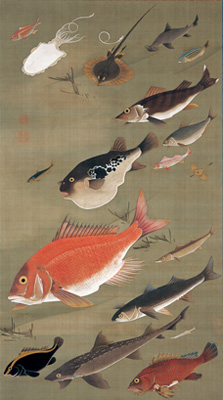
Rosho-hakuho-zu (Old Pine Tree and Peacock) from Jakuchu Ito’s Doshoku Sai-e (Colorful Realm of Living Beings). Doshoku Sai-e is a series of 30 paintings* created between about 1757 and 1766. Held at the Museum of the Imperial Collections.
(Photo: Courtesy of the Imperial Household Agency)
X-rays are actually a form of high-energy light with very short wavelengths, making them ideal for a wide array of scientific applications. Technology allows us to see and analyze both objects that emit X-rays and those that block their transmission. Today, Japanese researchers are capitalizing on the properties of X-rays to examine cultural assets, helping us to better understand their composition and preserve them for future generations.
Caring for a Nation’s Cultural Heritage
Dr. Yasuhiro Hayakawa has X-ray eyes. Not literally, of course, but in his role as head of the Analytical Science Section of the Center for Conservation Science and Restoration Techniques at the National Research Institute for Cultural Properties, Tokyo, he uses X-rays to reveal what some of Japan’s most precious cultural artifacts are hiding.
“Experts agree that these treasures should be maintained as they are,” he says. “We must not alter their surfaces, colors, shapes or external features; it is imperative to obtain information about such valuable objects without touching or damaging them. Even rust is considered part of these works of art, and it must be kept in place. ‘Nondestructive,’ ‘noncontact’ and ‘keeping things as they are’ are our key principles. For analysis, we use light and energy — X-rays.”
However, Dr. Hayakawa noted that X-rays are radioactive, and “there’s a possibility that they may deteriorate the condition of artworks. It is important to know the pros and cons of using X-rays so we can employ them in the most effective ways while conserving cultural properties to hand down to future generations.”
Dr. Hayakawa specializes in X-ray fluorescence (XRF) analysis, a process in which X-rays are targeted on an object to analyze the type and quantity of its elements. When the X-rays “hit” the object, this in turn generates XRF that reveals the composition and proportion of its elements. X-rays reveal information that humans cannot perceive with the naked eye. For cultural properties, XRF can clarify the techniques, materials and pigments in use when a work of art was created, and help us understand an artist’s intentions. The information can also be employed to determine the ideal conditions for conserving an object.

Dr. Hayakawa developed a portable XRF device that enabled on-the-spot analysis of cultural properties. The device has been used to analyze the colors in some of Japan’s most celebrated cultural properties, including the murals at the Takamatsuzuka tumulus, a portrait of Kichijoten, the goddess of fertility, fortune, luck, beauty and merit, the Tale of Genji picture scroll, and the Red and White Plum Blossoms and Irises screens by Korin Ogata.
- *The subjects include fauna and flora such as plants, birds, insects and fish.
Secrets of the Golden Feathers

Jakuchu Ito’s Gungyo-zu (Fish Picture), part of Doshoku Sai-e (Colorful Realm of Living Beings), contains 18 different subjects. Ito painted the body of Aulacocephalus temmincki Bleeker, the fish with a yellow stripe along its body (bottom, left), with Prussian blue, a pigment imported from Germany.
(Photo: Courtesy of the Imperial Household Agency)
One of Japan’s most renowned cultural treasures, Doshoku Sai-e (Colorful Realm of Living Beings) is a 30-scroll set of paintings on silk by Jakuchu Ito (1716-1800). Painted between about 1757 and 1766, this monumental work underwent a repair and restoration process from 1999 to 2005. During that time, when new paste was applied to the layers of silk and paper comprising the paintings, Dr. Hayakawa examined the pigments using his original portable X-ray device. His analysis revealed some stunning secrets of one particular painting, Rosho-hakuho-zu (Old Pine Tree and Peacock), which shimmers with incredible gold highlights.
“It was generally accepted that the peacock’s feathers were treated with gold paint and glue,” Dr. Hayakawa says. “But X-ray fluorescence analysis revealed there was no gold paint at all.”
Old Pine Tree and Peacock was painted on many layers of tightly woven silk cloth called eginu, backed by layers of paper. The X-ray analysis showed that Ito created the gold effect by manipulating the silk with different colors. He brushed yellow ocher on the back of eginu, and black on the backing paper. Then, by painting white over the silk, all the colors combined to create the stunning gold hue.
Another surprising discovery was that the artist had used a Prussian blue pigment, imported from Germany, to paint another scroll, Gungyo-zu (Fish Picture). It was one of the earliest uses of this color in Japan. So, X-rays revealed an entirely new “universe” within Ito’s art. But what can they tell us about the universe that lies beyond the Earth?

Light means visible light in the strictest sense. But light also sometimes includes infrared and ultraviolet light. Generally, it also covers radio waves and gamma rays. The speed of light in a vacuum is about 300,000km/sec.
Researchers also utilize methods other than XRF to view cultural properties. X-ray radiography enables 3D examination of objects such as screens and sculptures, while emissiography is used to study layers of paints. Spectroscopic analysis via visible light or ultraviolet light is employed for studying organic-based dyes, because XRF cannot identify airborne light elements such as carbon and nitrogen.
- 1. X-rays Reveal the Mysteries of Cultural Treasures
- 2. What Can X-rays Tell Us about the Universe?
- 3. X-rays Encounter the Infinitesimal World of Atoms

